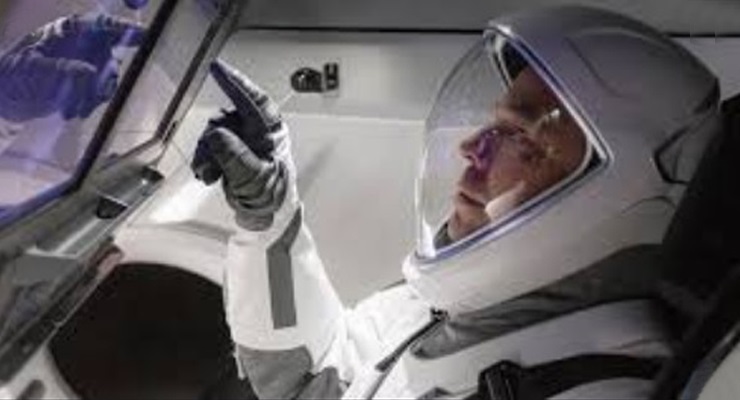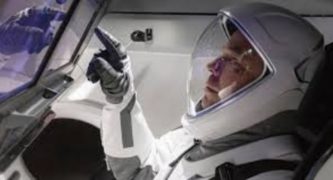
UPDATE: The historic NASA/SPACEX launch has been rescheduled to Saturday due to bad weather.
This week, Caltech alumnus Robert Behnken (MS ’93, PhD ’97) and fellow astronaut Douglas Hurley are scheduled to blast off from NASA’s Kennedy Space Center in Florida, headed for the International Space Station aboard a SpaceX Dragon spacecraft.
The mission, dubbed Launch America, is historic: Behnken and Hurley will be the first two Americans to take off for space on an American rocket from American soil since the space shuttle program was shuttered in 2011; since that time, spacebound Americans have flown aboard Russian Soyuz spacecraft.
Behnken, who earned his Caltech degrees in mechanical engineering, also served as chief of NASA’s Astronaut Office from 2012 to 2015. In 2014, ENGenious—the magazine of the Division of Engineering and Applied Science—spoke with Behnken at the Johnson Space Center in Houston to discuss his journey to becoming an astronaut, the impact that engineers can have on space travel, and the future of human space flight.
ENGenious: What inspired you to become an engineer?
Behnken: My father is a construction worker, and when I was young I saw firsthand a lot of the projects that he worked on. Whether it was pumping stations, pipelines, or something else, I was interested in all the machinery being constructed or that made the construction possible. But since I also spent some time working as a construction worker in the summertime in St. Louis, I also learned that it might be nice to have a job where air conditioning was at least sometimes available! At that age, I could do it, and it paid relatively well so it was worth the effort, but as a lifelong career, it can be quite a bit harder on your body than being an astronaut.
ENGenious: How has your Caltech education influenced you?
Behnken: My graduate adviser was Professor Richard Murray (Thomas E. and Doris Everhart Professor of Control and Dynamical Systems and Bioengineering, BS ’85), and he espoused a hands-on approach combined with a strong theoretical background. That’s probably the thing that’s been the most valuable, being able to translate the mathematics or theory into real things. For example, when we go out for a spacewalk, someone has to understand and then manage the risk associated with the theoretical charging levels on a large structure that’s moving in low Earth orbit. We need to understand the physics behind this and what the repercussions are going to be. Practically, that translates into something very real: What is the risk of electric shock to the astronaut inside the space suit, and how do we best manage that?
ENGenious: How has your Caltech experience helped in your career?
Behnken: One of the things that was really brought home to me at Caltech was the importance of taking a jack-of-all-trades approach to problem solving. When it came time to do research, we didn’t have the mindset of being a specialist who only looks at one little area. If you needed to learn to write computer code, you learned how to write computer code. If you needed to build an experiment, you built an experiment. You addressed the problem from all directions and picked up whatever skills you needed to go forward on it. Those I learned from at Caltech had the perspective that you’re going to earn one advanced degree, and while maybe it’s in mechanical engineering, that shouldn’t limit you. If you need to learn electrical engineering to do your research, if you need to learn physics—learn those things. The degree you had earned shouldn’t constrain your ability to learn in any area required to address your research.
ENGenious: How can Caltech medical engineers assist astronauts and the astronaut program?
Behnken: Historically, the space program has been a driver for many of the medical devices that eventually became commonplace. Every time we do a spacewalk, we are instrumented to have our electrocardiogram (EKG) monitored on the ground throughout the entire event. That type of physical monitoring capability is an area that we would definitely like to expand.
It is extremely cumbersome to bring samples back from the ISS. As we continue to move toward doing more biological science on board, if for example monitoring devices become implantable, we’d certainly be interested in taking advantage of them. Devices that allow us to not need to return samples would be hugely beneficial as well as medical examination equipment that crewmembers can use on their own with limited coaching from a ground team. For example, we regularly do a significant number of eye exams in orbit now because it’s been discovered that the geometry of astronauts’ eyes are changing during prolonged exposure to the ISS environment. It’s unclear if it’s due to a zero-gravity-induced fluid shift that increases intracranial pressure, carbon dioxide in the environment changing the chemistry of the blood, or some other phenomenon resulting in pressure on the back side of the eye and changing the shape of the eye and impacting the optical nerve. So we have new equipment on board to measure this phenomenon and provide the data to the investigators multiple times throughout the mission (in the past we only had the pre-flight and post-flight measurements). This is one of many biological phenomena that we need to address, many of which are resulting in new, exciting areas of research. There are of course engineering hardware challenges as well, at least as numerous as the medical challenges.
ENGenious: What will it take for humans to travel deeper into space?
Behnken: I mentioned the eye phenomenon that astronauts are facing right now. There are other areas from a physical-phenomenon perspective that need to be managed in preparation for a longer stay in space than we have on board the space station. The biggest challenge is the radiation environment, and as you can imagine, there are many ways to address this challenge. Adding shielding that physically protects you from that radiation environment is one solution, but spaceships can only be so big and so heavy before they are unaffordable or impractical for other reasons. There’s also a solution that takes a longer view and focuses on healing the cancer after it begins to develop. That solution could help lots of people, not just astronauts in space. A similar but a nearer-term solution is to focus on early detection of the cancer or other impacts of radiation so you have a better chance of effectively dealing with them. It’s interesting because, whether it’s medical professionals or physicists or engineers, there’s room for everyone to contribute to the ability of humans to travel deeper into space.
To read the full interview, go to https://caltechcampuspubs.library.caltech.edu/2971/1/alumni_behnken.pdf.














 7 comments
7 comments


